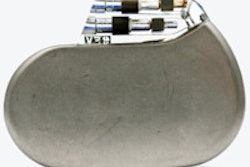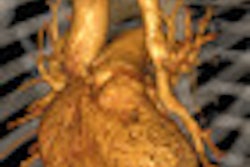
Intra-atrial right coronary artery (IARCA) anomalies are rare, but when detected at coronary CT angiography (CCTA), they often indicate the presence of other cardiac anomalies, according to a new Polish study published in the European Journal of Radiology (EJR).
Among more than 8,000 patients referred for CCTA, researchers found just 15 coronary artery anomalies -- all originating from the right coronary sinus, and nearly all found among middle-aged women presenting with atypical chest pain and/or arrhythmias. But none were diagnosed with significant coronary artery stenosis (EJR, 1 May 2014).
IARCA anomalies in patients referred for CCTA are usually found in middle-aged women who are susceptible to supraventricular arrhythmia, the authors wrote. The intermediate-term prognosis of patients with IARCA anomalies is good, but problems can occur when the anomalies are discovered during cardiovascular interventions. The long-term prognosis remains a question mark.
IARCA anomalies are generally considered benign, however, "an inadvertent violation of the right atrium while dissecting the IARCA carries a potential hazard for invasive endovascular procedures involving right atrial cavity such as right heart catheterization, pacemaker implantation, or electrophysiological ablation," warned Dr. Maksymilian Opolski and colleagues from the Institute of Cardiology and the Medical University of Warsaw in Poland. "Thus, it is of upmost importance for both cardiologists and radiologists to be aware of the IARCA and its potential implications on procedural risk and planning."
IARCA's telltale sign of a contrast-enhanced right-coronary artery within the lower attenuated right atrial cavity can be readily detected by CCTA -- but not conventional invasive angiography, they noted. The study shows that CCTA does what coronary angiography cannot for in vivo evaluation of the anatomic course and radiologic characteristics of IARCA segments.
"With the purely luminographic visualization of coronary arteries conventional angiography is not able to determine the anomalous course of right coronary artery (RCA) in low-pressure atrial cavity," Opolski et al wrote. Without CCTA, palpation and visualization during bypass are the only reliable way to detect the condition. As a result, there is little beyond a few case histories to IARCA's prevalence.
"In contrast, the widespread clinical application of coronary computed tomography angiography with the potential for 3-dimensional coronary artery visualization with regard to neighboring structures, has offered a unique opportunity for preprocedural detection of IARCA that may alter the surgical and catheter-directed interventions," they added.
Except for scattered case reports from CCTA images showing, as the authors put it, "inadvertent violation of the right atrium while dissecting the IARCA for bypass grafting," data have not been compiled on the prevalence and anatomic characteristics of IARCA in the adult population, questions the authors aimed to answer with their study.
With some exclusions from the pool of more than 9,700 patients, the study analyzed 9,284 (mean 60 ± 11 years, 49% male) who underwent CCTA at a high-volume center between 2009 and 2012, further assessing case reports mentioning the presence of IARCA, Opolski and colleagues wrote. IARCA anomalies were diagnosed whenever a contrast-enhanced segment of the right coronary artery was "completely surrounded by the blood pool of the right atrium on multiplanar reconstructed images," they added.
No patients with IARCA anomalies were excluded for poor image quality. The authors performed a clinical records review of the cases, recording patients' symptoms at referral, and obtaining follow-up data by telephone interviews and through patient records.
All were scanned on a second-generation dual-source CT scanner (Somatom Flash, Siemens Healthcare) using ECG tube-current modulation at 35% to 45% and 65% to 75% of the R-R interval, and slice thickness of 0.6 mm with a 0.4-mm increment. One-fifth of the patients (n = 1,825) were scanned using a high-pitch protocol, using a tube current of 320 mAs per rotation, tube voltage of 80 to 120 kV, a pitch of 3.2 to 3.4, and temporal resolution of 75 ms.
CTA scans with IARCA were analyzed off-line on a Leonardo workstation (Siemens Healthcare) by consensus of two experienced observers blinded to all patient data, who examined the anatomic characteristics of IARCA using multiplanar reconstructed images, maximum intensity projections, and 3D volume-rendered reconstructions, the authors wrote.
For each IARCA the observers recorded the high course of the RCA running above the atrioventribular groove, the high division of the RCA into the posterior descending and posteriolateral branches, total length of intra-atrial segments, mean diameter of the RCA immediately proximal and distal to the intra-atrial exit and entry sites, and the presence of atherosclerosis throughout the intra-atrial segments. The observers also looked at the intramuscular course of the left anterior descending (LAD) artery and the anomalous origin of the coronary arteries.
Rare, and mostly in women
IARCA anomalies were present in just 14 of 9,284 patients (0.15%) with 15 intra-atrial segments at a length of 14 to 53 mm, and a mean diameter proximal to the entry site of 3.3 ± 0.7 mm, the authors reported.
Compared with non-IARCA anomaly patients, IARCA anomalies were usually associated with an intramuscular course of the LAD artery (29% versus 4% for non-IARCA p = 0.001) and anomalous origin of the left circumflex artery (LCX) artery from the right aortic sinus (14% versus 0.3% for non-IARCA, p = 0.001). Fully 86% of IARCA anomaly patients were women with supraventricular arrhythmias in a cohort of 49% men.
IARCA anomaly patients were also younger on average (60 ± 12 years versus 54 ± 14 years for non-IARCA patients, p = 0.037) and more often women (51% versus 86%, p = 0.013).
No adverse events had occurred at 30 months' follow-up, except for episodes of supraventricular tachycardia occurring in 36% of the subjects.
The authors reached three main conclusions: that IARCA anomalies occur rarely and are often associated with additional coronary anomalies; that the clinical profile of patients with IARCA anomalies among CCTA population is most often represented by middle-aged women with susceptibility to supraventricular arrhythmia; and that patients with IARCA anomalies have a good intermediate-term prognosis.
"We believe that with the increasing application of CCTA, rare anomalies such as IARCA are likely to be recognized more often than before," they wrote. "Indeed, this should be even more valid since conventional coronary angiography, unlike CCTA, has no ability to detect the anomalous RCA running in low-pressure atrial cavity."
The findings in this study were largely in line with previous reports. For example, the IARCA traversed exclusively along the inferolateral portion of the right atrium, and the IARCA ranged in length from 14 mm to 53 mm.
Notably, no significant atherosclerotic plaques were seen within IARCA and its 2-cm-long surroundings in the study, they wrote. "Thus, similar to intramuscular segments of the LAD, the IARCA might be protected from the atherosclerotic process." They cautioned, however that the data at this point do not allow for definitive conclusions on this issue.
In summary, the authors gave CCTA high marks as a "useful noninvasive tool for diagnosis and in vivo characterization of IARCA. We believe that these observations might have far-reaching consequences in early identification, tailored interventions, and monitoring of patients with IARCA, and should warrant future studies in better understanding of the clinical significance of IARCA," they concluded.



















